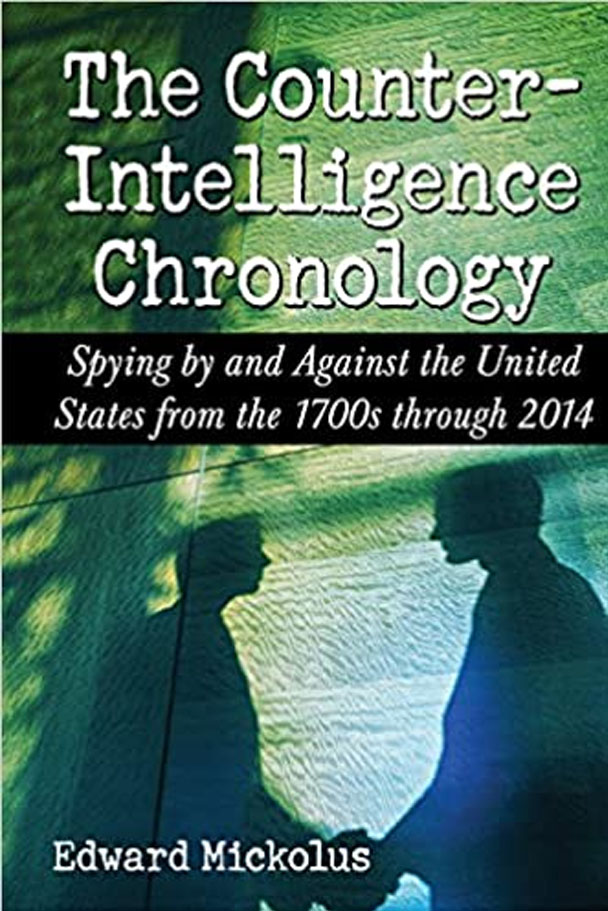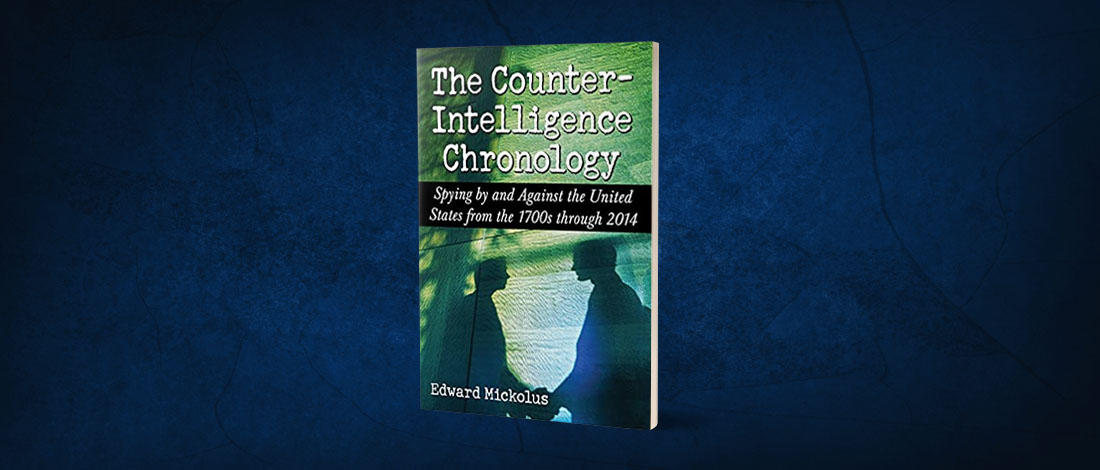Spying in the United States began during the Revolutionary War, with George Washington as the first director of American intelligence and Benedict Arnold as the first turncoat.
The history of American espionage is full of intrigue, failures and triumphs–and motives honorable and corrupt. Several notorious spies became household names–Aldrich Ames, Robert Hanssen, the Walkers, the Rosenbergs–and were the subjects of major motion pictures and television series. Many others have received less attention.
This book summarizes hundreds of cases of espionage for and against U.S. interests and offers suggestions for further reading. Milestones in the history of American counterintelligence are noted. Charts describe the motivations of traitors, American targets of foreign intelligence services and American traitors and their foreign handlers.
A former member of the U.S. intelligence community, the author discusses trends in intelligence gathering and what the future may hold. An annotated bibliography is provided, written by Hayden Peake, curator of the Historical Intelligence Collection of the Central Intelligence Agency.
- Title : The Counterintelligence Chronology: Spying by and Against the United States from the 1700s through 2014
- Authors : Edward Mickolus
- Publisher : McFarland
- Publication Date : July 30, 2015
- Paperback : 240 pages
- ISBN-10 : 1476662517
- ISBN-13 : 978-1476662510
- Item Weight : 15.2 ounces
- Dimensions : 7 x 0.48 x 10 inches

Review
“Exhaustively detailed and thoroughly researched…recommended” ―ARBA;
“Provides a one-stop guide for use of reference for brief case synopses regarding espionage. This chronology shows us that, time and again, American enemies do not give up after a spy or two is captured, but continue their activities against American interests” ―ProtoView.
Table of Contents
Introduction
Acknowledgements
The Chronology
Appendix A: Alleged American Spies
Appendix B: Alleged Foreign Spies
A Guide to the Literature of Counterintelligence: From Pickle-the-Spy to the Conficker Worm by Hayden Peake
Further Reading
Index
Introduction
Spying, as a profession, second career, or just an avocation, can be traced back to Biblical times; there are more than 100 references to such activities in the Bible. Joshua, son of Nun, was probably the most famous early espionage agent, ordered by Moses to scout Canaan. Few nations have been able to survive for long without some intelligence on its enemies—and for that matter, its fair-weather friends. Spying has been with us since before the invention of the nation-state, as tribes, city-states, and individual gangs have sought to keep up to date on where the next challenges will emanate. Alliances come and go, and leaders—of governments, corporations, or other organizations—need to keep up on what those outside of the group can do (commonly called “capabilities” in intel-speak) and are considering doing (“intentions” in the same dialect).
When I was managing new counterinteligence (CI) officers—and every intelligence officer is a counterintelligence officer—there was no one-stop-shopping book to which I could refer them that would give them thumbnails on the cases that preceded their work. There were numerous memoirs by spies, studies of individual cases, and examinations of various services, but no simple guidebook to the hundreds of cases that pockmark our history. This book is written to fill this gap. It is not intended to provide exhaustive detail on any case. It more modestly offers a quick précis of a case, with suggestions for further reading at annex. Several major espionage cases have made some spies—Aldrich Ames, Robert Hanssen, James Nicholson—household names and the subjects of major motion pictures and television series. A host of others, many limned below, have popped up before, during, and after my career. While it is relatively simple to remember the major cases, the not-so-famous and fleetingly famous are more difficult, yet have important lessons for us. This chronology is designed to let our next generation of intelligence officers, as well as the American people in general, know that our enemies do not give up after a spy or two is wrapped up, and continue their activities against US interests. These thumbnail sketches are intentionally brief; further details are available in the works noted in the bibliographic essay and general bibliography that follows this list. The bibliography was written by America’s foremost scholar on the literature of counterintelligence, Hayden Peake, who for many years has served as the curator of the Historical Intelligence Collection of the Central Intelligence Agency, and who has written hundreds of book reviews for Studies in Intelligence, publications of the Association of Former Intelligence Officers, and scholarly publications devoted to intelligence and national security.
During my 38-year affiliation with the US Intelligence Community, there has been a depressing amount of work for our counterintelligence colleagues who focus on espionage. (See Appendix A and Appendix B for a partial listing of their in-boxes.) (For purposes of this volume, “espionage” will generally refer to human penetrations of organizations to obtain secrets. Discussions of the myriad technical espionage methods—satellite/aerial reconnaissance, signals interception, cryptanalysis, and the like—while key methods of intelligence, are beyond the scope of our coverage.) Their focus is essentially on Big CI (protecting the key national security information of the country—not just limited to the files of the US Government, but also industrial secrets, weapons information, etc.) and Little CI (rooting out moles and other flavors of spies).
In developing these entries, we relied on descriptions offered in the books and websites in the two bibliographies that follow this chronology. We found particularly helpful—and authoritative—the websites of federal agencies with counterintelligence roles—the FBI, USMC, National Counterintelligence Center (NACIC), National Counterintelligence Executive (NCIX), and CIA—the work of the Defense Personnel and Security Research Center (PERSEREC), the newsfeed of the Association of Former Intelligence Officers (AFIO), the newsletter of the CI Center, plus innumerable conversations with our colleagues in these organizations.
While this chronology aims at illuminating the historical espionage threat against US interests, it is not limited to cases involving Americans happening on American soil. (For a listing of the Americans cited in the chronology, see Appendix A.) Spying against Western and allied governments and firms frequently involve the theft of US secrets, whether of national security or corporate intellectual property. Hostile services look for access to American secrets, and if they cannot penetrate a US organization, perhaps they can get the same information by targeting a less-well-protected third party. When appropriate, these third-party cases involving American interests are included. Moreover, while this volume focuses on spying mostly conducted by agents of the Soviet Bloc and later Russia (for a partial list of identified hostile intelligence service agents, see Appendix B), I have included mentions of spying by third countries against fourth parties to offer some context for the environment in which counterintelligence organizations operate. Credibility of these third- and fourth- party allegations, however, is frequently suspect, with regimes often using the specter of spying to whip up anti-Western and anti-dissident public opinion, rather than illuminating true espionage threats. There are also a few instances of industrial espionage involving official secrets, although most of these would otherwise be included under our earlier criteria.
For further flavor of the espionage environment, I have added major milestones in counterintelligence history, including formation of key Western and Soviet Bloc organizations; changes in laws regarding espionage, counterintelligence, and intelligence collection; birthdates and tenures of CIA directors and deputy directors; and birthdates of other individuals who had a major impact on present-day counterintelligence practice. It also notes defections of members of hostile intelligence services, with notes on their activities, when known. In many cases, details of their espionage work remains classified by the recipient governments. In most cases, the main entry regarding a specific spy case is keyed to the date on which the individual(s) was/were arrested, if known. Second choice is the date of sentencing of the perpetrator(s). In some cases, I have had to use some other key date in the spy’s career as a turncoat, such as date of walk-in, date pitched by the hostile service, or even date of death (in instances in which discovery of their espionage was posthumous). To permit ease of access of these cases for researchers, I have also included a brief (usually one-sentence) mention of such things as the perpetrators’ trial dates, dates of conviction, dates of sentencing, birthdates, and any other relevant chronological material. In the charts that follow, the date(s) that appears after an individual’s name refers to the date(s) his/her name appear(s) in the chronology.







